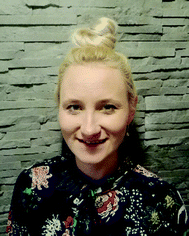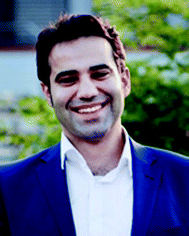Themed issue on electronic properties and characterisation of perovskites
Małgorzata
Kot
a,
Chittaranjan
Das
 *b,
Derya
Baran
c and
Michael
Saliba
d
*b,
Derya
Baran
c and
Michael
Saliba
d
aApplied Physics and Semiconductor Spectroscopy, Brandenburg University of Technology, Cottbus-Senftenberg Konrad-Zuse-Strasse 1, 03046 Cottbus, Germany. E-mail: malgorzata.sowinska@b-tu.de
bInstitute for Applied Materials-Energy Storage System, D-76344 Eggenstein-Leopoldshafe, Germany. E-mail: chittaiit@yahoo.com
cKing Abdullah University of Science and Technology (KAUST), Physical Sciences and Engineering Division (PSE), KAUST Solar Center (KSC), Thuwal, 23955, Saudi Arabia
dUniversity of Fribourg, Adolphe Merkle Institute, Chemin des Verdiers 4, CH-1700 Fribourg, Switzerland. E-mail: miliba@gmail.com
In a series of photovoltaic technologies developments, perovskite solar cells (PSCs) are the latest one and have already achieved an efficiency of 23.7%.1 Moreover, the flexibility to use different low temperature processes such as coating and printing as well as vapour deposition techniques make them lucrative for commercialization.
The perovskites used for solar cell devices are typically hybrid organic–inorganic materials with a chemical structure of ABX3, where A is the organic or inorganic cation (cesium (Cs), formamidinium, methylammonium), B is the metal cation (lead (Pb), tin (Sn)) and X is the halide (iodine, chlorine, bromine). The optoelectronic properties, and thus the performance, of PSCs can be easily manipulated by the choice and combination of cations and anions. However, PSC performance depends not only on the chemical composition of the perovskite absorber but also on its crystallinity, morphology and the interfaces with the charge collection materials.
Besides that, the possibility to alter the optoelectronic properties of the perovskite makes it also an excellent material for various other application such as light emitting diodes, resistive random access memories, X-ray imaging detection devices, lasers, etc. However, for large scale perovskite device fabrication the efficiency and stability are not optimized yet, causing concern.
Therefore, after achieving a remarkable improvement in PSC efficiency in a very short span of time, the community is now focused on the optimization of stability as well as the understanding of the working principles.
Namely, the performance of PSCs critically depends on the interfaces between the individual layers. For instance, efficient generation of charges, extraction, and transport with minimum recombination through interlayer interfaces is crucial to attain high efficiencies. During film formation, unexpected reactions may occur that in effect may change the expected energy band positions and thus the charge transport properties across the layers. The interfacial reactions often lead to the degradation of the PSCs and hence to performance and stability degradation. Besides that, the perovskite film itself can be grown as an intrinsic n-type and/or p-type material depending on the used substrate.
Most of the preparation methods like spin-coating, co-evaporation, vapour-assisted deposition, etc. developed to prepare perovskites result in films with polycrystalline grains. The adjacent grains may assume different crystal orientations or have different chemical compositions, which impacts charge excitation and dynamics and thereby the overall performance. The unbalanced charge accumulation or depletion between grain boundaries and grain interiors can cause band bending, which affects the separation of photoexcited electron–hole pairs and charge carrier transport across the interfaces formed between grains. Therefore, it is crucial to investigate the correlation between local electronic properties and local morphologies.
This themed issue in Journal of Materials Chemistry C has assembled a selection of scientific articles on the preparation and application of perovskite materials. In this issue one can find a collection of articles dedicated to theoretical as well as experimental work on the development of perovskites and contact materials, improvement of PSC performance and stability, interface engineering in solar cells and application of perovskite materials in resistive random access memory as well as light emitting diodes.
For example, in most cases it is found that elemental Pb contributes to the defect sites in the perovskite film acting as recombination center for photogenerated charge carriers. Therefore, detailed knowledge of additive chemistry is desired to elucidate the passivation mechanisms and facilitate further improvements. A new mechanism by which optoelectronic properties of perovskites can be chemically modified is proposed by Kerner et al. (DOI: 10.1039/C8TC04871A).
Long-term stability of PSCs is a must-have for commercialisation. Fedwa et al. (DOI: 10.1039/C8TC06308G) theoretically studied the fluorination of organic cations and its effect on the intrinsic stability of the perovskite. Using density functional theory, the authors found that the methylammonium cation undergoes structural deformation and results in a suppressed iodine vacancy mediated through diffusion under electrical load.
Moreover, Lyubov et al. (DOI: 10.1039/C8TC04488K) found that the all-inorganic CsxPbI2Brx perovskite with a certain non-stoichiometry has an efficiency around 10% and a higher stability than the stoichiometric ones under real-world operating conditions.
In addition, in this themed issue Connell et al. (DOI: 10.1039/C8TC04231D) reported a new low-cost organic hole transporting layer called TAT-tBuSty, crucial for up-scaling of next-generation high-performance metal halide PSCs.
Therefore, this themed issue provides a complementary mix of theoretical and experimental investigations towards improving stability and efficiency of PSCs, applications of perovskites other than solar cells, and reports strategies to optimize the performance of these devices as well as reducing the production costs towards commercialisation. It also demonstrates that the field remains wide open for further exploration with much scope for understanding and commercial exploitation of perovskite materials.
References
- https://www.nrel.gov/pv/cell-efficiency.html .
| This journal is © The Royal Society of Chemistry 2019 |




